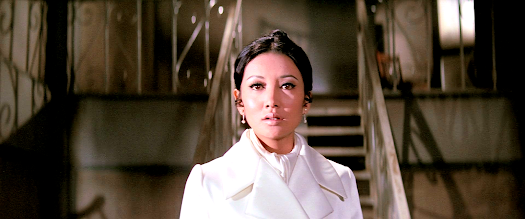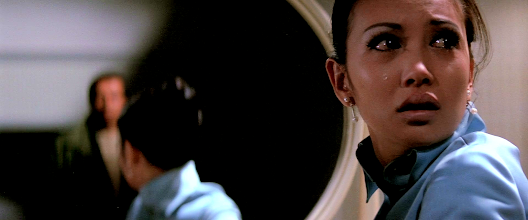 |
| Keiko Matsuzaka |
A little background may be useful here, so please bear with me before I get to the film…
In July 1950, the famous 500-year-old golden temple known as Kinkaku-ji in Kyoto was deliberately burned down by an apprentice monk named Yoken Hayashi, who made a suicide attempt immediately after but failed and was sentenced to seven years in prison as a result. His health worsened during his incarceration and he was released early, but died in 1956 aged just 26. Kinkaku-ji was successfully reconstructed in the intervening years and still stands today. Hayashi, who suffered from a severe stutter he was said to have had since the age of 3, never explained the reasons for his actions.
In 1956, Yukio Mishima published his novel based on the incident (known in English as The Temple of the Golden Pavilion). Mishima interpreted the crime as the result of an urge to destroy beauty – a recurring theme in his work The novel was filmed in a compromised version by Kon Ichikawa in 1958 as Enjo (aka Conflagration); a more faithful version by Yoichi Takabayashi appeared in 1976.
Another writer, Tsutomu Mizukami (or Minakami), had also become interested in the story from a different perspective. Mizukami had himself begun monastic training while still a boy, but was treated badly and quit by the time he was 18. He related to Hayashi, whom he even claimed to have met before the incident, and interpreted the crime as an act of rebellion against the hypocrisy of the temple authorities. Mizukami (who also authored The Temple of Wild Geese, another story involving a disaffected acolyte) carried out a great deal of research on the case and published his own novel inspired by it, Gobancho Yugiri-ro, in 1962. Shortly before committing his act of arson, Hayashi was said to have visited the same prostitute a couple of times in the red light district of Kyoto known as Gobancho, and Mizukami took this detail and created a major character out of her. In his novel, the two are childhood sweethearts from a struggling rural community who end up being sent (separately) to Kyoto by their families for very different reasons – he to train as a monk, she to work as a prostitute in a brothel as her destitute father has too many hungry mouths to feed.
Gobancho Yugiriro was first filmed in 1963 by director Tomotoka Tasaka. In his version, the prostitute (now named Yuko) is the focus of his film, with Hayashi (now Kunugi) not appearing until quite late on. In contrast, the version we’re concerned with here – directed by Shigeyuki Yamane and produced by Shochiku – balances its story more equally between the two principals. This is likely because Mizukami had published a second book about the Kinkaku-ji incident in 1979. Entitled Kinkaku-enjo (‘The Burning of the Golden Pavilion’), it was a non-fiction account which has yet to be translated into English. The opening credits of this film state that it is based on both books.
Yuko (Keiko Matsuzaka) is treated with apparent kindness by the madam, Katsue (Yuko Hama), whose brothel is named Yugiri-ro (providing the second half of the Japanese title). Although in neither film is this character treated with condemnation, she is, of course, involved in a sleazy business, and she arranges for one of her trusted regulars, the middle-aged ‘Ta-san’ (Hiroyuki Nagato) to take her virginity, and he becomes sexually-obsessed with her. Once that’s out of the way, Yuko takes to her new profession with disconcerting ease, and soon becomes the most popular prostitute in the place – with the clients, that is. Her colleagues soon get tired of being passed over and become envious. Meanwhile, Yuko secretly makes contact with Kunugi (Eiji Okuda), the stuttering apprentice monk she had grown up with and who is the only person she truly loves. She also feels responsible for his affliction as it began when they were children after she had accidentally dropped a snake on him while trying to get it out of a tree with a stick. He begins visiting her at the brothel, where she pays his fees, but, instead of sleeping together, they spend their time talking and singing songs they remember from their childhood. He’s supposed to be looking after the Golden Temple (here called Hokaku-ji), but he’s becoming increasingly disillusioned with his vocation and his relationship with the head priest (Shin Saburi) is deteriorating, while he sees little hope for a future with Yuko…
On the whole, I have to say that I prefer the 1963 version, mainly because I think it’s better cast and acted. Yuko is supposed to be 19 years old when she enters the brothel but, despite the fact that the 27-year-old Keiko Matsuzaka has not even the suggestion of a wrinkle, she somehow fails to convince as a teenager. However, having played leading roles in a number of successful films and TV dramas throughout the 1970s, she was a big star whose popularity was at its peak at the time this film was released. Some of the other performances also suffer in comparison to the earlier film – Hiroyuki Nagato overdoes it here (I preferred Minoru Chiaki in the 1963 version), while, as the madam, Yuko Hama is less memorable than Michiyo Kogure.
Another issue is that, although the film is set in 1950, it doesn’t always feel like it. A lot of little details don’t seem quite right – for example, the character known as ‘sensei’ played by Tadashi Yokouchi wears a polo-necked sweater and corduroy suit – was anyone really wearing that in 1950? And the cheesy music score which sometimes lapses into anachronistic distorted electric guitar doesn’t help either.
The one point on which I felt it improved on the previous film was in its portrayal of the ensemble of prostitutes who share the brothel with Yuko. In Tasaka’s film, we were given what looked like a very rose-tinted view in which it was basically one happy family with perfect manners and barely a hint of conflict or rivalry, whereas Yamane’s film shows the inevitable friction between the women, which even erupts into a catfight at one point, and their excessive make-up and gaudy clothes seem more fitting. But the film has little to say about the burning of the temple – ultimately, it’s simply a confection intended to appeal to those with a taste for romantic tragedies.
DVD at Amazon Japan (no English subtitles)























